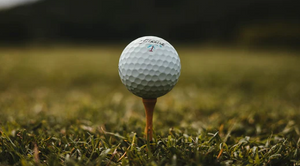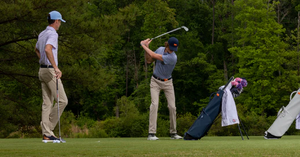What Is Golf Ball Compression?
To outsiders, a golf ball is simply a golf ball. But as any keen golfer will testify, your choice of ball can hugely affect your game. Both distance and accuracy can vary dramatically depending on what you're striking and how adapted to it you are. And there is no factor quite as important—and frequently misunderstood—as golf ball compression.
So, What Is Golf Ball Compression?
You draw your club back before unleashing a perfect swing that ends with a beautifully clean thump—it all happens in the blink of an eye. As they perfect movements like this, golfers find they become second nature and no longer need to consider each action individually. Another facet of the game that people rarely give a second thought to is what happens when a clubface slams into a ball at high speed.
The moment the clubface strikes a ball creates ball compression. The seemingly sturdy and solid golf ball changes shape and compresses due to the force. It happens too fast for the human eye to pick up, but you can see it when slowed down.
This blink-and-you've-missed-it moment, sometimes referred to as the ball's ‘activation,' is when the core becomes compressed. It springs off the clubface with tremendous force, hopefully sailing beautifully down the fairway and onto the green.
One critical point to remember is that not all golf balls are identical. They typically come with a compression rating, which tells users how hard the ball is and how much they compress on impact. All golf balls fall into a rating system between 30 (softest) and 120 (hardest).
To make things a little easier, we tend to divide them into three categories; low, medium, and high compression.
Low Compression
Low compression balls are classed as anything under 70 and are generally best for those with a slower swing—typically under 85 MPH. Low compression balls come with a larger core than those with a higher rating, requiring less speed to activate. They are considered the better option for beginners, novices, the elderly, and anybody with a high handicap.
These are usually 2-piece balls, with a large inner core and a cover that goes over it. Generally, they are the cheapest option, allowing those with a slow swing to get plenty of distance. However, the ball is much harder to add spin as a result.
Mid Compression
Medium compression balls fall between 70 and 90 on the rating system. They are best for those with a swing speed of between 85 and 100 MPH. They have a smaller core than those with a lower rating and therefore require a little more effort to strike.
Medium-rated balls can either be 2-piece or, more likely, 3-piece. The latter means that there is an extra layer between the ball's core and its outer layer.
The 3-piece balls are more expensive and produce more spin. Players with a faster swing also can hit them further than 2-piece balls.
High Compression
Anything over 90 falls into the high compression category. These balls are generally reserved for professionals and anybody with a firm grasp of the game.
These balls work best at swing speeds above 100 MPH. Generally, they come with a 4-piece layout, meaning yet another layer in the middle.
High compression 4-piece and even 5-piece balls are the most expensive on the market. They also produce the highest spin rates across the board, along with the best control.
How Does Golf Ball Compression Impact Distance?
OK, now we've straightened out what ball compression means. Let's move on to one of the factors most commonly—and not always accurately—associated with golf compression: hitting distance.
With high compression balls used by professionals, it can be easy to assume that the higher the compression rating, the further you’ll hit the ball. However, that's not the best way to look at things. It's much better to focus on swing speed instead.
Those with a slower swing speed can hit a low compression ball further than a high compression ball simply because it takes a much lower speed to activate the ball's core. The results might be a little mixed for those with a mid-level swing speed, somewhere between 85 and 100 MPH. You might get a further distance with a lower-rated ball but more control and spin with a higher model.
The real reason professionals use high compression balls is not necessarily because they go further when you hit them. Instead, these players usually come with swings well over 100 MPH. The swing speed is more than enough to send that ball a considerable distance even when it requires more force to activate it.
Another point to bear in mind is that players with a fast swing speed will not get the same benefit of a low compression ball as those with slower swings. A ball with a compression rating of 30 struck by a 115 MPH swing will often have a negative outcome for the player. It could compress too much, meaning it remains an odd shape during flight for much longer than normal, which will affect the flight path and may slow the ball down.
Is a Higher Compression Golf Ball Better?
Most golfers these days will tell you that ball compression is much less of a factor than in the past. Technology has developed rapidly, making it much harder to define golfers by a single swing speed. In theory, different compressions could be used for different situations on the golf course, though due to the rules of the game, it's usually the done thing to stick with one grade of ball throughout the round.
We've already discovered that high compression doesn't necessarily equal further distances for most golfers. The same restraint applies when determining which golf ball is ‘better.' Only around 5% of the golf market uses balls with the highest compression rating. While it's tempting to say they are the best, they're not the best balls for most golfers out there.
In short, higher compression isn't necessarily the better ball. It might sound like a cop-out, but the best ball will be different for everybody. It's a much better idea to try and match your ability, swing speed, and circumstances.
However, there are a few general takeaways when talking about ball compression.
Balls with a lower compression generally come with higher launch angles. They have less of the dreaded sidespin and more forgiveness (when a shot happens to come off, even when poorly hit). These positives are counted by a lack of general control when compared with balls with higher compression. They’re also much harder to apply that all-important backspin to keep you on the greens. These balls maximize distance for those without the required speed for higher compressed models.
Mid-level compression balls lie in the middle and are appropriate for the largest section of golfers. They provide more control and better spin options, but their higher compression means they require a faster strike.
Balls with the highest compression rating are not necessarily the best golf balls, but the best golfers in the world use them. They come with the best control and spin and are ideal for those who know what they're doing on the golf course.
Do You Want High or Low Compression Golf Balls?
When finding the ideal golf ball for your game, it's best to start with two factors: your driver distance (how far you hit the ball off the tee) and your swing speed. Once you have this information, it's generally a case of simply matching up where you are to industry recommendations.
However, before we move on to specific recommendations, there’s one final point that we shouldn’t overlook. As mentioned earlier, technology has come a long way in a relatively short period. It's becoming increasingly common for golfers to go with what feels suitable rather than what a chart tells them to use.
How a ball feels when it comes off your club can significantly impact any golfer. A ball with a very high compression rating can feel too hard when struck, especially for those more delicate shots in and around the green. Many golfers prefer a slightly softer feel when hitting the ball.
This factor is complicated further by the final coating on golf balls, usually urethane, ionomer, or surlyn. Much of the ball's control comes down to this final layer. You’ll typically find ionomer and surlyn used for balls with lower compression and urethane used by professionals and those with a lower handicap.
With so many factors impacting what compression level is suitable for you, the best advice we can give here is to match your swing speed and driver distance to the golf ball compression.
Swing Speed of <90 mph
If your swing speed is below 90 mph, your driver's distance is likely under 200 yards. For those in this situation, we recommend using a low compression ball, but it's important to remember that this is a sliding scale.
The closer you get to 80 or 90 mph, you begin to stray into the mid-compression territory. In this case, it's always a good idea to move up a level to help you further improve your game.
Swing Speed of 90-100 mph
Those with a swing speed between 90 and 100 mph can probably hit a ball at least 250 yards or even a little further. Golfers in this category will likely fall into the mid-handicap region and should therefore be using medium compression balls, rated anywhere between 65 and 90.
Swing Speed of >100 mph
If you've got that tanking tee off that sails over 100 mph, you're probably hitting the ball 275 plus yards, which places you not far off elite level. Players of this caliber should unquestionably be using high compression balls. Anything below means that they are not exactly getting the most out of their speed and distance.
Any balls above 90 are a good option here. However, this is also the area where personal preference begins to play a role. The highest level of compression might not be the best fit for you if you find something with a lower rating that you like the feel of more.
Does Golf Ball Compression Really Matter?
Ball compression undoubtedly plays an essential part in choosing the right golf balls for you. However, it's also not something you should fixate on when looking to improve performance. If you wanted to get incredibly technical, you could go to extreme lengths to match your exact swing speed to your precise compression number. Still, most settle on the three categories mentioned above and allow room for personal preference.
Whether you're looking to put your newfound knowledge of golf ball compression to use and purchase a new set for that next round or are simply searching for some new golf accessories, Stitch Golf should be your first port of call. For over a decade, we've been supplying golfers with everything they need to thrive on the golf course. We've got you covered from golf bags to polo shirts, from umbrellas to our finest club head covers.


